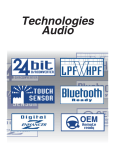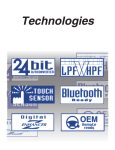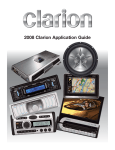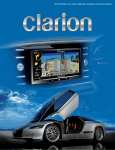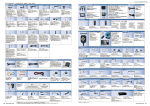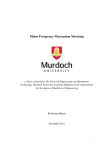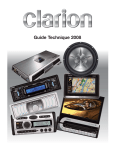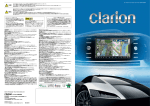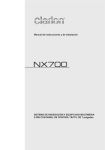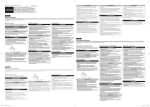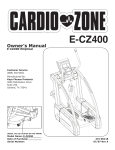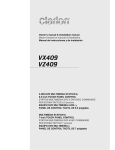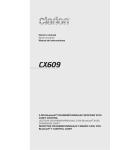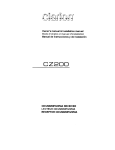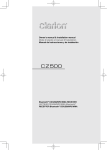Download Clarion FZ709 Specifications
Transcript
Audio Technologies Audio Technologies iPod Connectivity Most Clarion USB port equipped source units now feature USB iPod Audio Direct Connectivity. This allows you to connect your iPod to the source unit using the Apple supplied USB cable. USB iPod Audio Direct provides you the opportunity to select a song sorted by title, artist, album, genre, composer, or via playlist. Clarion’s commitment to iPod connectivity continued on in 2010 with the implementation of the new Apple iPod authentication chip incorporated into the CCUIPOD2 and CCUIPOD3. This chip allows for charging and video playback from the latest generation of Apple iPod’s, including the Apple iPhones. Virtually from the beginning of the Apple iPod reign, Clarion was at the forefront of iPod connectivity. By offering consumers GUI’s mimicking those commonly found on their iPod on multimedia command stations with high speed song and playlist search capabilities. And the ability to utilize their existing Clarion CD source units dating back as far as 2001 with their iPod. CCAIPOD (CeNET iPod Interface) > Compatible with 2007-2008 CeNET source units > Compatible with Marine source units: M455A, M475, CMD4A, CMD5 > Category direct access: Playlist, Artist, Album, Song, Genre, Composer > Some source units with CD-Text function have the capability to show ID3 TAG information > Charges most iPods. CCAIPOD CCA748 & CCA723 (iPod Audio Control / Video Playback Interface Cable) > Audio control and video playback with: FZ409,FZ709, NX500, NZ500, NX700, VX400, VZ400, CMV1 > iPod GUI (Graphical User Interface) on-screen display > On-screen display of: Podcast titles, Artist, Album, Song, Genre, Playlists, Composer > Touch-screen direct category access to: Playlist, Artist, Album, Song, Genre, Composer > Video Playback with compatible Apple iPods > Charges most iPods. Image courtesy of Apple iPod Interfaces and Cables CCA723 Please refer to the Clarion iPod Book to confirm compatibility between the source unit and iPod. EA1251B (CeNET Black Box iPod Interface) > Compatible with 2001-2006 CeNET Source Units > Simulates the iPod as a 6-Disc CeNET CD Changer > Requires “Clarion” playlists to be created > Some source units with CD-Text function have the capability to show ID3 TAG information > Charges most iPods. EA1251B 6 CCUIPOD1 (iPod Audio Control / Video Playback Interface Cable) > Audio control and video playback with: VZ300, VZ309, VX409, VZ409, CMS1, VRX485VD, MAX385VD > On-screen display of: Podcast titles, Artist, Album, Song, Genre, Playlists, Composer > Touch-screen direct category access to: Playlist, Artist, Album, Song, Genre, Composer > Video Playback with compatible Apple iPods > Charges most iPods. CCUIPOD2 (iPod Audio Control / Video Playback Interface Cable) Same Features as CCUIPOD1 > Features Apple’s latest iPod authentication chip for charging and video playback with the latest generation of iPods. > Audio control and video playback with: VX409, VZ409, CMS1, MAX385VD, VRX485VD Audio Technologies CCUIPOD3 (iPod Audio Control / Video Playback Interface Cable) > Audio control and video playback with: VZ300, VZ309 > On-screen display of: Podcast titles, Artist, Album, Song, Genre, Playlists, Composer > Touch-screen direct category access to: Playlist, Artist, Album, Song, Genre, Composer > Video Playback with compatible Apple iPods > Charges most iPods. Quick Access Category Selection With iPod capacities exceeding 100MB and the ability to store more than 30,000 songs, having the ability to get to your music quickly has never been more important. Clarion features Quick Access Category Selection to many of our USB equipped CD source units. The radio station preset buttons (1-6) have been assigned direct category access. Just press one of the preset buttons and the music on your iPod is instantly sorted by that selection. Presets: CCUIPOD1 CCUIPOD2 CCUIPOD3 1 2 3 4 5 6 Playlists Artists Albums Song Title Genres Composers iPod Technologies Bluetooth Connectivity ABC Search In 2009, Clarion introduced “ABC Search” to many of the USB iPod audio direct connect source units. ABC Search allows you to quickly navigate all the music on your iPod using the alphabet. You can select for a song title, artist, album, genre, composer, or playlist by selecting a letter of the alphabet. If you want to listen to “Punk” music, select the genre category and set the ABC Search to the letter “P”. You will now be able to start selecting genres that begin with the letter “P”. In efforts to promote driver’s safety and the safety of others, Clarion offers several source units featuring a built-in Bluetooth interface and a universal Bluetooth transceiver. Aside from hands-free phone operation, they’re also capable of Bluetooth audio streaming (A2DP) and audio/video remote control profiles (AVRCP). Video Playback Control Clarion offers a host of multimedia control stations that offer video playback when interfaced with the appropriate iPod interface cable. This allows you to choose from TV shows, video podcasts, movies, and music videos stored in your iPod right from the source unit. Video playback control isn’t limited to multimedia control stations, it can also be done with Clarion FZ409 and FZ709 source units when interfaced with a CCA723/CCA748 and an external monitor. For the mobile entertainment enthusiast, Clarion offers (5) five multimedia control stations and (3) three source units with an integrated Bluetooth interface and (9) nine source units that are Bluetooth Interface Ready. Clarion’s universal Bluetooth transceiver, BLT370, can be easily interfaced with any source unit with an auxiliary input. When interfaced with a Clarion Bluetooth Interface Ready source unit, the source unit will mute the audio signal allowing the phone call to be heard from either the left or right speaker. Devices that are capable of Bluetooth audio streaming, the BLT370 can be used to transfer the audio signal directly into the source unit. There is no compromise for safety and that’s why Clarion offers products with integrated Bluetooth connectivity and a universal Bluetooth transceiver compatible with any source unit. 7 Audio Technologies Bluetooth Accessories BLT370: Bluetooth Audio/Mobile Phone Transceiver > Can be interfaced with any source unit with an auxiliary input. > Bluetooth Audio Streaming (A2DP) > Muting Circuit for Bluetooth Interface Ready Source Units > 2.5mm stereo mini-jack auxiliary input for another audio device or microphone > Visor mount included to several piconets simultaneously. Piconets are established dynamically and automatically as Bluetooth enabled devices enter and leave radio proximity. A fundamental Bluetooth wireless technology strength is the ability to simultaneously handle both data and voice transmissions. This enables users to enjoy a variety of innovative solutions such as a hands-free headset for voice calls, printing and fax capabilities, and synchronizing PDA, laptop, and mobile phone applications to name a few. Bluetooth Profiles RCB204: Replacement Microphone for Source Units with Built-in Bluetooth Interface > Unidirectional microphone (minimizes background noise) > Integrated visor mount Replacement for: CZ500, CX609, CZ509, FZ709, FB275BT, FB275BTB RCB199: Optional External Microphone for Source Units with Built-in Bluetooth Interface > Unidirectional microphone (minimizes background noise) > Integrated visor mount Compatible with: NX500, NZ500, NX700, VX400, VZ400, CZ500, CZ509, VX709, CX609, VZ709, MAX675BT, VRX785BT Bluetooth Basics Bluetooth wireless technology is a short-range communications technology intended to replace the cables connecting portable and/or fixed devices while maintaining high levels of security. The Bluetooth specification defines a uniform structure for a wide range of devices to connect and communicate with each other. Bluetooth technology has achieved global acceptance such that any Bluetooth enabled device, almost everywhere in the world, can connect to other Bluetooth enabled devices in proximity. Bluetooth enabled electronics devices connect and communicate wirelessly through short range, ad hoc networks known as piconets. Each device can simultaneously communicate with up to seven other devices within a single piconet. Each device can also belong 8 Advanced Audio Distribution Profile (A2DP) A2DP describes how stereo quality audio can be streamed from a media source to a sink. A2DP defines the protocols and procedures that realize distribution of audio content of high quality in mono or stereo on ACL channels. The term “advanced audio,” therefore, should be distinguished from “Bluetooth audio,” which indicates distribution of narrow band voice on SCO channels as defined in the baseband specifications. Hands-Free Profile (HFP) HFP describes how a gateway device can be used to place and receive calls for a hands-free device. A typical configuration is an automobile using a mobile phone for a gateway device. In the car, the stereo is used for the phone audio and a microphone is installed in the car for sending outgoing audio. HFP is also used for a personal computer to act as a speakerphone for a mobile phone in a home or office environment. Headset Profile (HSP) The HSP describes how a Bluetooth enabled headset should communicate with a computer or other Bluetooth enabled device such as a mobile phone. When connected and configured, the headset can act as the remote device’s audio input and output interface. Object Exchange (OBEX) OBEX us a transfer protocol that defines data objects and a communication protocol two devices can use to exchange those objects. OBEX is designed to enable devices supporting infrared communication to exchange a wire variety of data and commands in a resource sensitive standardized fashion. The OBEX protocol also defines a folder-listing object, which is used to browse the contents of folders on a remote device. OBEX enables applications to work over the Bluetooth technology protocol stack as well as the IrDA stack. For Bluetooth enabled devices, only connection-oriented OBEX is supported. Three application profiles have been developed using OBEX that include SYNC, FTP, and OPP. Audio Technologies Object Push Profile (OPP) OPP defines the roles of push server and push client. It’s called push because the transfers are always instigated by the sender (client), not the receiver (server). OPP focuses on a narrow range of object formats to maximize interoperability. The most common acceptable format is the vCard. OPP may also be used for sending objects such as pictures or appointment details. USB Connectivity For 2010, USB connectivity continues to be the focal point in the development of (20) twenty multimedia, source units, and overhead monitors. USB connectivity enables easy music transportation and playback from your computer via USB Mass Storage Device (a.k.a. jump drives or compatible music player) to your Clarion source unit. In selected source units, it also provides USB iPod Direct Connect connectivity. Allowing iPod owners to connect their iPod using an USB cable with direct access to playlists, albums, artists, composers, and songs. An additional advantage of Clarion USB ports is they’re all powered. What does that mean? This means it can be used to recharge the battery of commonly used devices such as cellular phones, portable navigation units, iPods, and more through the USB port. Many Clarion USB equipped source units also feature support for USB Digital Media Streaming from MTP (Media Transfer Protocol) devices. Support for USB MTP devices dramatically increases the number of compatible USB drives with Clarion source units. USB Equipped Multimedia Control Stations with Built-in Navigation NX500, NZ500, NX700 USB Equipped Multimedia Control Stations VZ300, VX400, VZ400 USB Equipped Overhead Monitors VT810B, VT1010B, VT1510B USB Equipped Source Units CZ200, CZ300, CZ500, CX400, CX609, FZ409, FZ709 USB Equipped Marine Source Units M309, CMD6, CMV1, CMS1 USB Accessories CCAUSB (USB 2.0 Extension with Integrated Cover) > 1 Meter (39-inches) cable with gold plated copper contacts providing maximum conductivity with minimal data loss. > Up to 12Mbps > Works with USB 2.0 storage devices > Hot pluggable Requires 3/4” hole for mounting. NOTE: USB Mass Storage Class devices (a.k.a. jump drives) that require special software or contain software drivers may not be detected when connected to USB equipped source units. Check the manufacturer’s specifications before proceeding and try the combination before installing. Auxiliary Inputs For 2010, Clarion’s complete line up of multimedia command stations, sources units, overhead monitors, and head rest monitors all feature and adjustable sensitivity auxiliary input. This eliminates the need for crude and inferior-quality FM modulation of external audio source to a source unit. These dedicated auxiliary inputs make connecting a Bluetooth interface, portable music player, satellite radio receiver, video game station, video player, or computer very simple. Merely connect a standard audio cable from the audio source into the auxiliary input on the source unit or multimedia station. To ensure excellent sound quality and matching of the audio levels through the various sources on source unit or multimedia station, Clarion has incorporated an auxiliary level sensitivity adjustment. This reduces variations in the source volume while switching from the internal to an external audio source. In addition, it minimizes the audio clipping which can generate distortion and other unwanted noise. Auxiliary Equipped Multimedia Control Stations with Built-in Navigation NX500 (RCA A/V, 3.5mm A/V), NZ500 (RCA A/V, 3.5mm A/V), NX700 (RCA A/V) Auxiliary Equipped Multimedia Control Station VZ300 (RCA Video, 3.5mm Audio), VX400 (RCA A/V, 3.5mm A/V), VZ400 (RCA A/V, 3.5mm A/V) 9 Audio Technologies Auxiliary Equipped Headrest Monitors VMA700B (RCA A/V x2) Auxiliary Equipped Overhead Monitors VT810B (RCA A/V, 3.5mm A/V), VT1010B (RCA A/V, 3.5mm A/V), VT1510B (RCA A/V, 3.5mm A/V) Auxiliary Equipped Source Units CZ100 (3.5mm Audio), CZ200 (3.5mm Audio), CZ300 (3.5mm Audio), CZ500 (3.5mm Audio), CX400 (3.5mm Audio), CX609 (3.5mm Audio), FZ409 (3.5mm Audio), FZ709 (3.5mm Audio) Auxiliary Equipped Marine Source Units M109 (3.5mm Audio), M309 (RCA Audio, 3.5mm Audio), CMD6 (RCA Audio x2), CMV1 (RCA A/V x2), CMS1 (RCA Audio) OEM Steering Wheel Remote Interface Ready Multimedia Control Stations with Built-in Navigation NX500, NZ500, NX700 OEM Steering Wheel Remote Interface Ready Multimedia Control Station VX400, VZ400 Source Units CZ100, CZ200, CZ300, CZ500, CX400, CX609, FZ409, FZ709 PAC SWI-JACK Auxiliary Input Accessories Cellular Phone Mute Circuit CCAAUX (Female 3.5mm Stereo Mini-Jack to Male RCA Extension Cable with Integrated Cover) > 3.5mm Gold Plated 3.5mm Stereo Mini-Jack > 1 Meter (39-inches) OFC RCA cable with gold plated RCA connections > Integrated protective cover Clarion source units feature a cellular phone muting circuit, which will attenuate the audio and pause a CD/DVD during playback while this circuit is activated. Requires 3/4” hole for mounting. CCAAUX OEM Steering Wheel Remote Ready With more and more vehicles featuring radio controls integrated into the steering wheel, it is more important than ever to offer aftermarket source units capable of interfacing with them. That’s why Clarion offers a host of multimedia control stations and CD source units with the capability of adding a third party OEM steering wheel remote interface. These third party interfaces utilize the key functions found on the steering wheel, such as volume, mute, seek, track, band, and source controls. By allowing the driver to control the primary functions of the source unit from the steering wheel, it minimizes distractions and removal of the hands from the steering wheel to adjust the source unit. For additional information regarding OEM steering wheel interfaces, please visit: www.pac-audio.com 10 In its normal function, when a (-) ground signal is applied to the BROWN wire in the speaker/power harness of the source unit, the source unit will mute the audio output until the (-) ground signal is removed. This is designed to be used with Clarion BLT370 or cellular phone car kits. Clarion Bluetooth Ready source units feature a programming option that will, when enabled, switch the source unit to the auxiliary input when (-) ground is applied to the BROWN wire. This feature was designed to work with the Clarion BLT370. In-Dash Navigation Systems Clarion is a world leader in the development of GPS navigation systems, manufacturing OEM systems for the top automobile manufacturers in the world, including Porsche, Nissan, Infiniti, Volkswagen, Ford, and more. For 2010, Clarion offers (3) three multimedia control stations with built-in navigation and (2) two navigation ready multimedia control stations. The NX500 (6.5” double-DIN), NZ500 (7” double-DIN), and NX700 (7” double-DIN) all feature a built-in high speed flash memory navigation system. Each system contains over 12 million points of interests and various map viewing displays. In addition, text to speech street announcements, multiple route calculations, and different users modes. 3-D mapping available in selected cities as well. Audio Technologies Rounding off Clarion’s 2010 navigation ready multimedia control stations are the VX400 (6.5” double-DIN) and VZ400 (7” single-DIN). Both of these multimedia control stations are compatible with Clarion’s NP400, black box navigation add-on system. NP400 (”Black Box” Navigation Add-on System) > “Black Box” navigation add-on system > Audible voice commands in 3 different languages (English, French, and Spanish) > Flash memory of map data > SiRF GPSIII module with 20-channel GPS receiver > 2 Different user modes: Simple or Advanced Mode > Automatic route recalculation > Turn-by-Turn voice prompts > Text to speech > 3 Display Modes: 3-D Maps, 3-D Landmarks, NP400 and 3-D Icon > Lane information > No VSS connection required CCD Camera Input Clarion’s multimedia control stations feature a dedicated composite video (RCA) input for a rear vision camera to assist the vehicle operator will backing up. It can be interfaced with a Clarion Surround Sight camera system or any camera with a composite video output. In addition, these multimedia control stations feature a dedicated reverse trigger input wire that will switch the reverse camera image while the vehicle is in reverse and back to original screen when the vehicle is taken out of reverse. CK625E Multimedia Source Units with Camera Input NX500, NZ500, NX700, VX400, VZ400 2-Zone Entertainment Audio/Video Outputs Clarion’s NX700, multimedia control station is capable of 2-Zone entertainment. This function allows front seat passengers to listen to one audio source, while the rear passengers can enjoy another through an overhead or headrest monitor with wireless headphones. This allows you to connect the output of the internal DVD player or visual input to an external monitor. The audio/video output features a line-level audio signal. The connected device must have its own volume control. Compatible devices include overhead or headrest monitors with wireless headphones. The rear seat passengers can enjoy a DVD movie while the front seat passengers can listen to the radio tuner, iPod, or auxiliary input. Audio signal for the rear zone is a fixed level output allowing each rear passenger to adjust the volume independently through wireless headphones. Please review your source unit owner’s manual for limitations pertaining to 2-Zone functionality with respect to specific accessories. 2-Zone Capable Multimedia Control Stations with Built-in Navigation NX700 Video Distribution Any time a video signal is to be split and connected to multiple video sources, the use of a proper electronic video distribution amplifier is required. The Clarion VA700 provides (7) seven buffered video outputs from a single composite video input connection. Using the VA700 will ensure that the picture quality remains clear and sharp and the brightness and contrast levels are not altered. The use of Y-cables is not an option for splitting a composite video signals as the signal voltage determines the black level of the image, and will be altered when split. VA700 (Video Distribution Amplifier) > (1) Composite video input > (7) Buffered 75-ohm composite video outputs VA700 11 Audio Technologies Compressed Media Format Transmitting audio and data via satellite spawned the need to create various formats of media compression. These formats allow multiple signals to occupy the same bandwidth as an uncommonly compressed signal. This increased efficiency, reduces cost and allows more data to be transmitted at higher speeds. Clarion is at the forefront of compressed media file playback. For 2010, Clarion offers support for AAC, DivX, and MPEG compressed media files to our already extensive list. WAVE Format WAVE (.wav) files are considered to be uncompressed. This file format is used for the storage of 2-channel audio in digital form. The file is stored in PCM (Pulse Code Modulation) form and uses the standard 44,100 samples per second, 16-Bits per sample times two channels. The resulting data rate is 1,411.2 kbps. to 96 kHz are available and up to 48 channels can be encoded. AAC happens to be the default audio codec used on Playstation 3, PSP, Apple iTunes website, and iPod products. DivX At the forefront of compressed video technology is the DivX codec. The latest version of this codec is called DivX 6 (or DivX Media Format) reduces the file size of digital movies while retaining support for multiple audio tracks, interactive menus, chapter points, multiple video streams, and subtitles. For 2010, the Clarion NX700 (7” Double-DIN multimedia station) and CMV1 (3.5” Marine multimedia station) support the DivX Media Format in its native form. Offering high quality, fully interactive move playback. These units are fully DivX Certified. MP3 Format MP3 files gained popularity due to their reduced file size. MP3 stands for MPEG-1 Audio Layer 3. MP3 files use perceptual encoding to reduce files sizes while limiting the effect on sound quality. MPEG 1, 2, and 4 The Motion Picture Experts Group (MPEG) is a group that overseas the development of video and audio encoding standards. The various MPEG standards outline the capabilities of each compression format. The MP3 standard allows for bitrates between 32 kbps and 320 kbps with sampling rates of 32, 44.1 and 48 kHz. A higher bitrate represents less compression and better (relative to the original) sound quality. MPEG-1 This was the initial audio and video compression standard and later became the standard for the Video CD. It utilizes MP3 for the audio track. ID3 Tag Display ID3 Tags were created and inserted at the end of an MP3 file allow for the storage of metadata information such as song title, artist, album name, genre, and year. MPEG-2 This is the standard format for audio and video broadcasts for standard television. It is used for over the air broadcast, as well as Dish Network, digital cable, and some slight variations on DVDs. WMA Format WMA (Windows Media Audio) is a compressed audio file format created by Microsoft. It is very similar in concept to MP3 files, but includes provisions for DRM (Digital Rights Management). Microsoft originally claimed that WMA files had better sound quality than MP3 files recorded at the same bitrate. Subsequent double-blind testing have repeatedly confirmed that the file formats are very similar. AAC Format AAC (Advanced Audio Coding) is another form of compression and encoding format for digital audio. The AAC format has been made popular as it is the standard format for the Apple iPod. AAC offers more sample and bitrate options as compared to MP3 files. Sampling rates from 8 kHz to 12 MPEG-4 This is an expansion of MPEG-1 format and adds the ability to support audio and video objects, low bitrate encoding, 3-D content and support for Digital Rights Management (DRM). CD Text CD Text is an extension of the standard audio CD format and allows Album Name, Song Name, and Artist information to be stored on a standard audio CD. Source units bearing the CD Text Logo are capable of displaying this information from compatible discs. Not all store-bought CD’s are encoded with CD Text information. Audio Technologies Signal Processing Clarion products remain at the forefront of sound quality and performance. Our source units have features that allow your mobile audio system to recreate sound that is closer to the original recording than ever before. These features included advanced signal restoration for compressed audio, digital equalization, advanced D/A converters and digital storage systems. Clarion calls the concept of remaining true to the original audio recording Sound Genesis. This is at the heart of everything Clarion does. This image shows the sme snapshot of time as the first image, but after the track has been compressed to a 128kHz MP3 file. There is no audio information above 12kHz. BBE MP Compressed audio files allow a large amount of information to be stored in a small space. The drawback is that some of the audio information, particularly in the high frequency range is lost. Clarion introduced BBE MP (Minimized Polynomial Non-Linear Saturation) in 2009. This is an advanced audio processing technology that restores high frequency content to not only compressed media files (MP3, WMA, and AAC), but to CD recordings as well. BBE MP can restore high frequency content all the way up to 24kHz through oversampling at 48kHz. Harmonic processing has been tailored to focus on off-ordered harmonics. This is similar to what makes vacuum-tube amplifiers sound warm and rich. This image shows the exact same snapshot of time after the signal has been processed by BBE MP. You can see that high frequency content has been restore right out to 24kHz. Here is a graphical example of how BBE MP processes audio data and restorers high frequency information. This image shows how BBE MP can effectively process an original CD quality recording and restore high frequency content that is lost due to the limitations of the CD format. The best way to demonstrate BBE MP is to let your customers listen to an MP3 file on your display board and turn the BBE MP processing On and Off. This image shows a snapshot of the frequency response of a conventional audio CD (16-Bit, 22kHz). You can clearly see that frequencies above 22kHz are rolled off. BBE MP processing has four settings on Clarion source units: Off, Low, Mid, and High. Depending on the quality of the source being listened to, you may need to adjust the BBE MP processing to achieve life-like sound. 13 Audio Technologies Z-Enhancer Plus Making system tuning as easy as possible is one thing Clarion prides themselves on with Z-Enhancer Plus. Z-Enhancer Plus incorporates three preset equalization curves, each with an adjustable effect level. In Custom Mode, you are given control over Bass Gain (-7 to +7), Bass Frequency (60, 80, 100, or 200Hz), and Bass Q-Factor (1, 1.25, 1.5, or 2). For high frequency adjustment, you can adjust gain (-7 to +7) and center frequency (10, 12, 15, or 17.5kHz). Beat EQ (3-Band Parametric Equalizer) Beat EQ provides 3 preset equalization patterns - BASS BOOST, IMPACT, and EXCITE - Clarion’s Beat EQ even lets you freely customize the level and range of the bass, midrange, and treble portions of each pattern. You can tune the sound to your liking, depending on the category of music, for a more fulfilling listening experience. Excite: Emphasizes Bass and Treble while de-emphasizing the midrange. Impact: Emphasizes Bass and Treble Beat EQ also offers a custom preset, which allows you to adjust the bass, midrange, and treble Q-factor (bandwidth), Boost and Center Frequency. Bass Boost: Emphasizes Bass 14 Audio Technologies Electronic Crossovers Electronic crossovers are designed to pass only a certain range of frequencies through a circuit. There are two types of electronic crossovers: High-Pass and Low-Pass Bass: Boost: -12 to +12dB Q-Factor: 1, 1.25, 1.5, or 2 Frequency: 50,100, or 200Hz Mid: Boost: -12 to +12dB Q-Factor: 1.5 or 2 Frequency: 700Hz, 1Hz, or 2kHz Treble: Boost: -12 to +12dB Frequency: 8kHz or 12kHz Beat EQ is featured in the following source units: CZ100, CZ200, CZ300, CZ500, CX609, FZ409, FZ709 Magna Bass EX Conventional loudness circuits boost bass frequencies around 100Hz. This results in a muddy over-boosted sound which is unnatural. Magna Bass EX focuses the bass boost at 50Hz, adding warmth and richness to the sound. This 50Hz boost effectively extends the frequency response of smaller speakers, making your system sound larger and more capable. The result is dynamic bass performance that sounds real. A High-Pass crossover will allow only those frequencies above (higher than) the crossover point to pass through. This type of crossover is used on tweeters to protect them from low and midrange frequencies and on midrange drivers to protect them from low frequencies. A Low-Pass crossover will only allow those frequencies below (lower than) the crossover point to pass through. This type of crossover is used on subwoofers to keep midrange and high frequencies from being reproduced. A combination of High- and Low-Pass crossovers may be used to filter both high and low frequencies passed to a device such as a midrange or mid-bass driver. This is called Band-Pass crossover. There two important numbers to consider when considering a crossover - the cutoff frequency - fc and the crossover slope. The crossover frequency determines the point at which the filter will start to work. For example, a High-Pass crossover set to 100Hz will attenuate the frequencies below 100Hz and pass frequencies above 100Hz. Crossover slope describes the rate which the crossover attenuates those frequencies. Speakers are designed to operate within a specific range of frequencies. Sending frequencies to a speaker that was not designed to handle, reduces its performance and could result in poor sound quality. For 2010, Clarion incorporated an electronic High-Pass and Low-Pass crossover into the following source units: CX609, FX409, FZ709, and NX700 The electronic crossovers found in Clarion source units not only affects the pre-amp outputs, but the signal being sent to the internal amplifier as well. This means you can use a high power source unit to run your speakers, while an amplifier and subwoofer can handle the low frequency output. Clarion’s electronic crossovers are all adjustable for frequency and are easy to implement. 15 Audio Technologies Digital to Analog Converters Converting digitally stored information (such as that found on a Compact Disc or DVD) back into an analog signal is the job of the D/A converter. The D/A converter reads each 16-bit word from the disc and assigns it an analog voltage. A conventional D/A converter repeats this task 44,100 times a second. The accuracy of the D/A converter in terms of voltage and timing are a key component to determining the sound quality capabilities and noise output of the source unit. 1-Bit Digital to Analog Converters A 1-Bit D/A converter works by comparing one bit of information to the one previous to it. If the new bit is higher than the previous one, it increases the output voltage. If the new bit is lower than the previous, then it decreases the output voltage. A filter on the output of the D/A converter smooths out the signal and the result is a reproduction of the original audio waveform. 24-Bit Digital to Analog Converters Clarion source units featuring our 24-Bit D/A converter bring new realism and detail to your music. 24-Bit converters offer several benefits as compared to a conventional 1-Bit D/A converter. Primarily, a 24-Bit D/A converter significantly increases dynamic range capability, reduces quantization error and removes jitter. The result is music that sounds more realistic, especially in the high frequency range. Cymbals become clearer and more detailed. Ambience and room effects become more accurate. The entire listening experience takes a step forward in fidelity and authenticity. This effect can be clearly heard on even the most basic of audio systems. Comparing one source to another, even when using four factory speakers will reveal a very significant improvement in performance. Low Impedance Preamp Output All Clarion preamp outputs feature low output impedance drive circuitry. Output impedance is most commonly looked at in terms of resistance measurement, in the case of Clarion’s preamp outputs, this specification is ~330 Ohms. This has several effects in terms of sound quality as 16 compared to products that have high output impedances (1,000+ Ohms). More of the audio signal voltage is passed to the load device. The preamp is capable of driving lower impedance loads in the event RCA Y-cables be used. The audio signal is less susceptible to frequency response degradation caused by reactances in the RCA cables or the input stage of the amplifier or processor. Many processors and amplifiers use DC blocking capacitors on their inputs. When a high-impedance source unit is connected to these loads, the bass and treble performance can suffer. Low impedance outputs result in flatter frequency response and more output from your amplifiers. CD Operation Safeguards Clarion’s CD operational safeguards allow the CD mechanism to detect disc size, prior disc-in-drive detection, foreign object detection, and allow for auto reload. Clarion’s CD mechanism uses photo sensors and LEDs to identify 3” or 5” compact discs. Clarion’s CD mechanisms uses a tapered roller to precisely center the CD onto the drive spindle. A tapered loading-roller precisely centers the CD onto the drive spindle. Since the roller mechanism is tapered, only the edges of the CD are touched, thereby eliminating the possibility of scratches. These operational safeguards allow safer CD disc handling, preventing jams from accidental loading of two CDs, and help to reduce service problems by detecting foreign objects in the drive mechanism. Zero-Bit Detector Mute Clarion CD Players feature a zero-bit detection mute circuit. This circuit turns off (mutes) both the line-level and speaker-level outputs when it does not see a digital signal for 750 milliseconds. Since a digital signal consists of “one” and “zero” bits, the zero bit detector will turn off the analog audio input signal to the preamp section when it sees a series of zero bits. The purpose of this circuit is to eliminate tracking noise or background noise that is typically associated with the decoding of the digital signal to its final analog form. Audio Technologies CEA-2006 Ratings Instant Station Recall (ISR) All new Clarion amplified products have been rated using the CEA-2006 specification. This specification was created to allow power production numbers to be compared between one brand and another brand without concern for measurement type. Getting to where you want to go should always be as easy as simply pressing a button. When it comes to your favorite radio station, ISR has you covered. Tune in your favorite radio station, then press and hold the ISR button. You can choose AM or FM - it doesn’t matter. Now, any time you want to listen to that station, simply press the ISR button. The CEA-2006 specification states that power measured using this format will be constant through the entire specified audio bandwidth range. The power measurement will be taken with 14.4V being supplied and the distortion from the output signal can’t exceed 1%. Just as with the power ratings, Signal to Noise (S/N Ratio) measurements will follow similar guidelines. The S/N Ratio measurement will be taken at a power level of 1 Watt into a 4 Ohm load. This means that all device measurements will be comparable, no matter how much power the product produces. MOSFET Power IC There’s only one way for Clarion’s source units and amplifiers to deliver unyielding power output and linearity: MOSFET amplification, or Metal Oxide Semiconductor Field Effect Transisitor amplification. Smaller and more efficient than conventional power supplies, a MOSFET amplification circuit delivers power with less distortion and zero On/Off switching noise. This means you can crank up the volume or set it to easy listening. Either way, your sound will be crystal clear. Message Information Personalization is always on our minds - we want the right clothes, the right car, and the right music to match our personal style. Clarion knows this, and has included the Message Information option as one of the screen savers on our source units. Users can enter a message up to 30 characters in length and have it scroll across the screen. This is a great feature to use on all-news radio stations when you want up to the minute traffic information. Key Off Eject Have you ever forgotten to bring your favorite CD into the house after arriving home from a trip? With Clarion’s Key Off Eject feature - the disc eject function works, even when the ignition isn’t turned on. Press the eject button and the disc pops out. Last Position Memory As CD players started to become popular, many people started to experience inherent drawbacks of this random access storage media. With a cassette tape - it stays where you left it when you shut off the power. Then, when you turn it back on, playback resumes from that same point. With Clarion’s Last Position Memory - the same is true for your CD player. Turn the car off, do your shopping, then get back in. Your music picks up where you left off. High Resolution Liquid Crystal Displays All Clarion liquid crystal display screen use the latest in active matrix technology to give you the brightest, most detailed image available. Thin Film Transisitors (TFT) are attached to each RGB (red/green/blue) pixel to provide more control over the color being reproduced. This method helps reduce display “white-wash” associated with a conventional passive-matrix screen, and helps to ensure optimal picture quality. By employing a “”striped pixel configuration” to align RGB pixels into columns, we can use more pixels to enhance details and provide better color definition. Having the controls for brightness on the front panel allows easy adjustment of picture quality. 17 Audio Technology LCD Display Resolution Clarion’s in-dash liquid crystal displays feature a screen resolution of 1440 X 234 pixels for a total of 336,960 pixels. Some companies try and confuse you by describing the number of picture elements - each of the red, green, and blue picture elements. By their standards, these units would have 1,010,880 picture elements. When comparing video displays, make sure the specifications you are comparing are using the same format. H.M.I. Clarion has long been considered the industry leader in the development and implementation of advanced Human Machine Interface designs and concepts. Back in 2006, Clarion took the H.M.I. concept to the next level and made it the focus of the companies products. H.M.I. refers to the interaction, interconnection, and interdependance of man, music, and machine - all while being easy to use. When your finger moves into the fringe capacitive field that leaks outside of the top plastic layer, this changes the strength of the field on the receiving layer. The Capacitance to Digital converter can sense this and sends a signal to the source units micro controller, which then interprets that as a button push and responds in accordance. What are the benefits of the Capacitive Touch Interface? There are two primary functionality benefits. Capacitive Touch buttons have no moving parts. This means that they are resistant to failure. Also, with no moving parts, there is no way for contaminants to infiltrate the system and cause a malfunction. This can be anything from dust or cleaning solutions that can get trapped inside of a button. Capacitive Touch Interface In 2004, Clarion introduced a truly innovative concept to the head unit category, a head unit with no buttons! The DXZ945MP proved to be ahead of its time, but its acceptance was huge. It offered a large monochromatic display with touch sensitive “bean” shapes for navigation through the functionality of the head unit. With a simple swipe of the finger, you can scroll through radio preset stations, change system settings, or randomize the tracks on a CD. In 2009, Clarion felt it was time to introduce another revolutionary concept to the masses, the FZ409 and FZ709 and the NEW Capacitive Touch Interface. These sleek looking source units feature a smooth control panel with illumination capacitive sensor button areas. This is an example of the intuitive H.M.I. design that minimizes the number of moving parts while maximizing functionality. Since only relevant button icons appear for the task at hand, button hunting is eliminated and access is more direct and responsive. How does Capacitive Touch Interface work? Behind the fixed plastic escutcheon are two plates, one is a transmitter and the other is a receiver. The plates are designed in the shape of the button area. A high frequency capacitive field is generated between the two plates and a capacitance to digital converter records the strength of the field on the receiving plate. 18 FZ709 Dimmer Input Safety comes in many forms - but being able to concentrate on your driving is a fundamental part of the H.M.I. concept. Driving at night adds an additional level of complexity. To make it as easy as possible, Clarion includes a dimmer input circuit on many of source units. When connected to the factory dash illumination circuit, a signal on this wire causes the deck to reduce the brightness of the radio display, preventing it from being a distraction. Safety in the form of simplicity. Audio Technologies ISO Mounting Capability A product designed for easy installation makes sense, not only for the staff performing the installation, but for the end user as well. When a radio looks like it belongs in the dash, all the experiences surrounding its operation just seem better. Clarion’s single-DIN and double-DIN source units are capable of being installed in ISO mount fashion. This means, no trim ring is required to install the radio or to have its detachable control panel function properly and be removable. ISO mounting typically means that factor style brackets are to be used. Clarion source units feature industry standard mounting holes on the side of the radio that align perfectly with these brackets. This reduces installation time and improves the look of the final product. Many new installation kits make use of these ISO mounting techniques, allowing radios to be installed so they look like they belong. CX609 installed into 2008 Nissan Versa NX500 installed into 2007 Isuzu I-290 CZ500 installed into 2004 Subaru WRX 19















